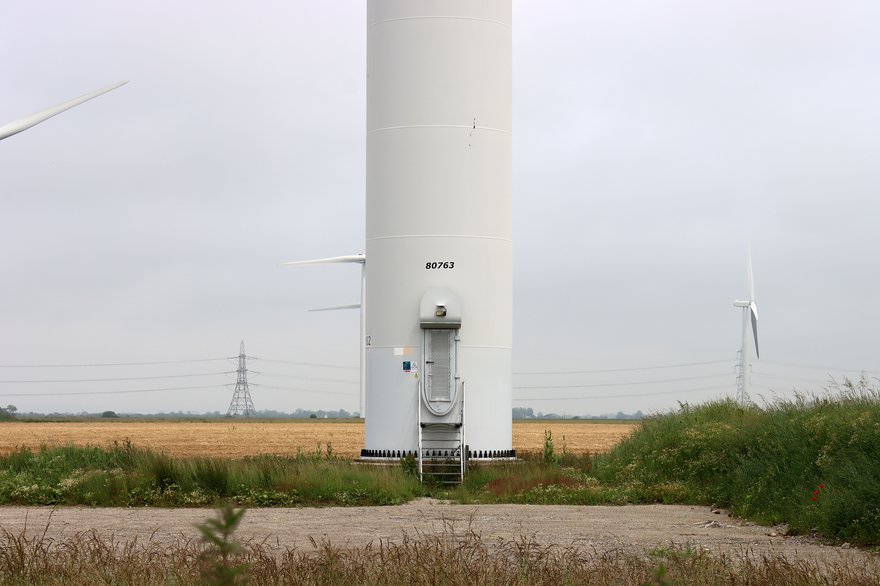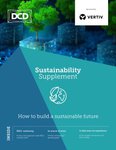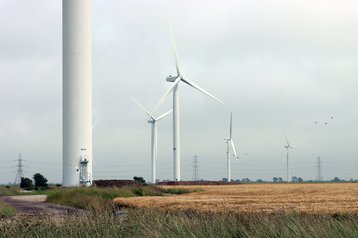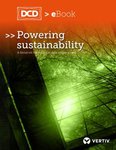In our race to get off of fossil fuels, sunshine and wind have proven to be our best chance of harnessing renewable energy and providing clean power.
Solar panel efficiency has soared massively, allowing more power to be harvested from less land. With wind turbines, huge improvements have also been found - mainly by becoming huge.
Put simply, there are two key factors to bear in mind. First is the speed of the wind: power potential increases with the cube of wind speed, so doubling the speed increases power by a factor of eight. Then there's the size of the turbine blades, where double the diameter increase available power by a factor of four.
Building larger turbines takes advantage of both of these circumstances. By going higher, you generally get access to higher wind speeds, and you have more space to build the enormous blades that take advantage of those winds.
In numbers, a 57m high wind turbine can generate about 1MW, while a 95m turbine can generate 3MW, according to the Department of Energy. A 120m high turbine can generate 17MW.
This basic concept has led the direction of the wind turbine industry for the last three and a half decades, noted Shashi Barla, the head of analysis and intelligence at renewable energy advisory Brinckmann. "That has been the drive all these years, because the larger the turbine, the higher the energy yield."
There is a problem, though. As you go higher, things get complicated.
Let’s start with on-shore wind turbines. First, there is a simple cost issue: for years the economics have been in favor of growth, but current designs are reaching a point where the excess metal and infrastructure to support larger turbines could cost more than they are worth. A 2022 study found that 120m was the optimal height on modern turbines, before the extra investment didn’t make sense.
Then there’s the basic challenge of getting the component parts from the factory to their site. A giant blade or turbine tower simply cannot wend its way through underpasses, across bridges, and around highways, putting a fundamental limit on the turbine’s hub height - the distance from the turbine platform to the rotor of an installed wind turbine.
“The biggest challenge is logistics, by far,” Barla said. “For onshore we have almost reached stagnation. In the last four years or so, for the first time in the wind industry, new turbine product introductions have slowed down significantly.”
On-shore turbines in the US, have reached as high as 94m, but would struggle to achieve this.
The DOE’s Wind Energy Technologies Office hopes to help solve the issue, working with turbine companies to make the machines more modular, and is trying to see if it is possible to construct parts on-site - all while dramatically increasing the number of turbines dotted across the country.
“When we look at the United States, one of the things we are really interested in is deploying a lot more wind to meet the Biden-Harris administration’s decarbonization goals. And to do so we’ll need five to ten times more deployment than we have today, so a lot more turbines,” DOE wind turbine program manager Mike Derby said.
“Then there is the economic value to the country we are looking at as well. We would like to manufacture these turbines locally in the United States, so we are looking at innovation for longer and larger blades and how we get that manufacturing to come back to the United States.”
Spiraling success
Earlier this year, a potentially transformative project began to take shape in Texas.
Partnering with GE, Keystone Tower Systems took tech borrowed from pipemaking to develop a spiral-welded wind turbine tower. Essentially it takes a huge steel sheet and rolls it into a tower on-site.
This solves the transportation issue (at least for the tower, not the blades), allowing for turbines to grow larger. When it received a $5 million grant from the DOE in 2019, Keystone said it believed the method would allow it to produce towers with more than 7m diameters, allowing for hub heights of 180m and beyond.
In late February this year, Keystone built the first of such towers. Coming in at 89m, it is already at the upper limit of US land-based turbines. Certified for a 40-year lifetime, the tower is currently seen as a simple replacement for GE's standard towers, and features GE's 2.8-127 turbine.
But the hope is that future towers will be larger and, crucially, cheaper. A National Renewable Energy Laboratory (NREL) study in 2019 found that around half the Levelized Cost of Energy (LCoE) of a wind farm came from the cost of the wind turbine, with around 10.3 percent of costs represented by the tower.
With traditional designs, the taller the turbine, the more money proportionally that goes into the tower - the capex of a 110m tower is about 20 percent of the overall project. Add another 40m and it jumps to 29 percent.
Cylindrical towers rolled on-site could fix that, if Keystone can scale up its efforts across the country. It claims that it can make the towers 10 times faster than a traditional factory, and with 80 percent less manpower.
Alongside the effort, GE Renewables is experimenting with 3D printing to create customizable tower bases. The DOE has also launched the Big Adaptive Rotor (BAR) project, exploring flexible blades that could stretch 206m in diameter and be easier to transport as they could bend by 13° during the journey.
That would increase capacity factors by 10 percent or more over a typical land-based turbine, the DOE believes - equivalent to a single average turbine powering another 280 homes.
Flexibility brings its own issues, though. Even without BAR, as blades get longer, they tend to be more flexible, and it is more challenging to control them and mitigate loads so that you get the expected power.
There is also a shortage of cranes that are large enough to keep up with the growth of turbines, and keep pace with any height increases. This supply chain constraint has yet to be resolved in the US.
Across the world, permitting is another issue. "A major stumbling block is project permitting," Barla said. "Take a market like France, where you could spend about seven years in permitting an onshore wind project. And in that seven years, if you look at the technology, turbines will have completed two technology revolutions."
By the time the project gets a permit, the turbines it was designed around may no longer exist. Companies can apply for a fresh permit for newer, taller, and more efficient turbines, but that risks adding more time to the permitting stage.
"If they don't want to invest an additional two years to that, then they would restrict the project size based on the previous technical configuration," meaning a less cost-effective wind farm, he explained.
The good news is that European governments are aware that this is a highly flawed strategy, and have promised to cut down permitting timelines significantly - a small positive outcome from the energy crisis caused by Russia's invasion of Ukraine.
Another government restriction is on tip height, the overall peak height of a turbine including blades.
Ireland is hoping to massively increase its reliance on wind turbines, but the country has put in restrictions based on tip height to protect local communities.
In late 2019, the country expanded upon its 2006 noise standards to rule that wind turbines will have to be set back, with at least four times the tip height between a wind turbine and the nearest dwelling, and a mandatory minimum distance of 500m.
That means that a 180m wind turbine will have to be at least 720m from the nearest dwelling. Turbines also have to be kept away from roads and railways, by a distance equal to the tip height plus 10 percent. These and other tip height restrictions mean turbines have limited locations, or have to compromise on height.
"Because of those tip height restrictions, you will not be able to deploy the latest generation technologies in those markets," Barla said. "And so, as a consequence, your ability to lower the cost will also be constrained."
The open sea
Things get a little easier out to sea. No one lives nearby, and you don’t have to squeeze under an overpass to deliver the turbine.
This has allowed offshore wind turbines to grow rapidly.
"The height of offshore wind turbines is quite a bit higher than land-based wind," the DOE's technology manager for offshore wind R&D, Nathan McKenzie, explained.
The next step in offshore wind is to deploy turbines that have a capacity of 15MW. For comparison, the average offshore turbine size installed in 2020 was around 8MW, which is beyond the practical limits for most land-based turbines.
With this and other advancements, consultancy McKinsey believes that the levelized cost of wind-generated electricity could fall from around €150 ($159) per megawatt-hour (MWh) in 2015 to less than €50 ($53) per MWh by around 2024, a dramatic improvement.
At the same time, the company notes that the global installed offshore wind capacity is expected to grow from 40GW in 2020 to 630GW by 2050.
But, as with cranes on land, there are critical bottlenecks in construction that could thwart a rapid buildout. “Installing offshore wind farms relies on wind turbine installation vessels (WIV), which anchor to the sea floor, but there are not many of these vessels in the world,” the DOE’s McKenzie said. “Currently, there are 16 wind turbine installation vessels active in Europe and only two can handle 15MW turbines.”
Again, there are those hoping to innovate our way out of the problem. Maersk Supply Service has designed a new WIV which would be stationed permanently at a wind farm to carry out successive installations.
Built by SembCorp Marine, the WIV is expected to be delivered to US waters in 2025 by Kirby Offshore Wind. The partners hope the new design can cut installation costs by 30 percent, and increase the supply of WIVs.
The new vessel will be used by Equinor and bp for the installation of US offshore wind farms Empire 1 (816MW) and 2 (1,260MW) and Beacon Wind (1.2GW).
Should such supply chain problems be solved, other issues can arise in high winds. The problem is, we don’t exactly know what they are.
“We need to have wind assessment resource campaigns that go higher into the atmosphere, so we know exactly what we are putting the turbines into,” McKenzie said.
“We just redeployed a buoy off of Hawaii, and have the Wind Forecast Improvement Project,” all aimed at improving our understanding of what exactly happens in the skies above.
“As offshore wind blades are 100 meters plus in size, you start to get into aerodynamic phenomena that we don’t see in smaller scales,” McKenzie added. “So we are focused on understanding those particular aerodynamic regimes.”
Data will prove a huge help, as will computers. “With larger capacity turbines, you have to fully test these out before they go to sea,” McKenzie said.
“We see a huge benefit to increasing our capability to numerically test, with better desktop models that can fully analyze these turbines prior to bringing them out to sea.”
Even with these advances and a concerted effort, it’s possible that wind turbines’ ever-growing heights will start to slow, both at sea and on land.
That may not necessarily be a bad thing.
"In the last three and a half decades, the primary evolution was increasing the size," Barla said. "There are a plethora of innovations that are happening within the turbine, but that's been the drive all these years."
With larger turbines no longer a reliable easy win, Barla hopes that we will see a flurry of innovation in a number of other areas.
"About six years ago, Vestas came up with a multi-rotor technology, which is by far one of the biggest innovations in the market," he said. It was unable to get traction at the time, but now China (which it should be noted has been able to build bigger on land and at sea than everywhere else) has begun to try to replicate the technology.
Chinese company Mingyang offers the world's largest onshore wind turbine at 8.5MW (soon to be bested by a 10MW system from local rival Envision Energy)But it is now experimenting with a twin rotor design, Barla said. They are also looking at downwind machines, that have the rotor placed on the lee side of the tower.
Over in Europe, another frontier is what to do with all this electricity, generated miles offshore, possibly at times when demand is low.
Instead of transmitting the energy to land over potentially lossy and expensive cables, companies are investigating converting into other forms on-site out at sea. Siemens is testing integrating hydrogen electrolyzers within offshore wind turbines.
Meanwhile, Vestas is looking at it putting electrolyzers onshore. Both proposals could prove critical in the development of green hydrogen.
"That's the innovation coming out beyond just increasing the size," said Barla.




